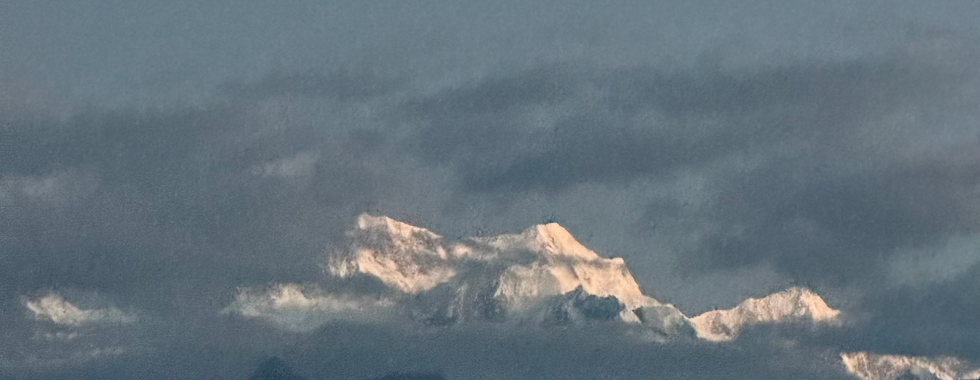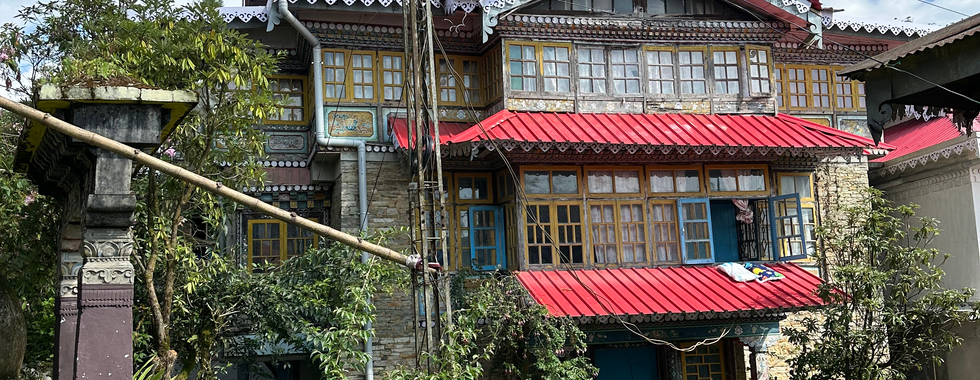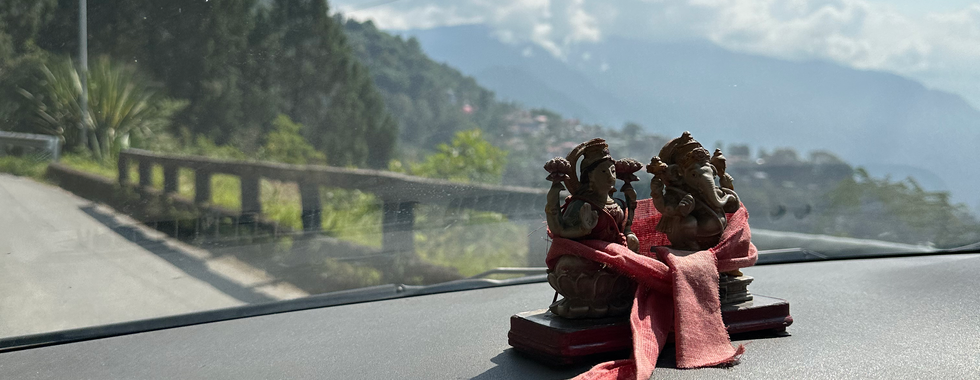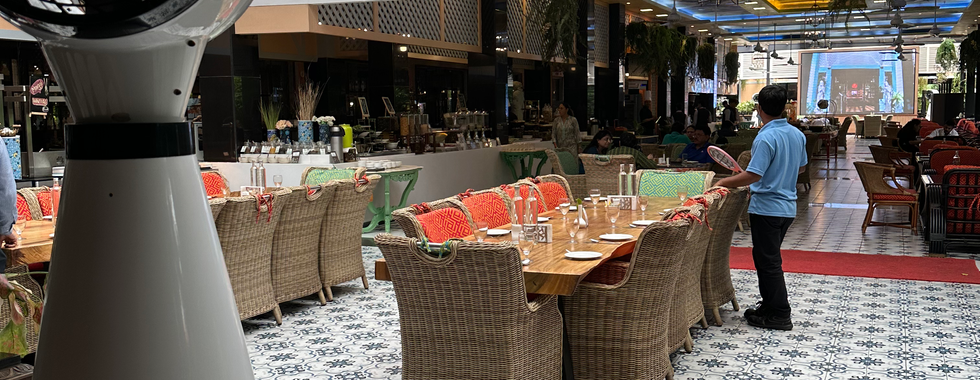Back to Bogdogra
- Oct 30, 2023
- 6 min read
October 10, 2023 - from the itinerary: Gangtok – Siliguri / Mayfair Tea Resort (B) This morning drive 24 kms/approx 45 minutes to Rumtek. Visit (aka Rumtek Dharma Chakra Center) a relatively new monastery. The construction stated in 1962 and was completed in 1968. But this is one of the most important monasteries, as it is the main seat of His Holiness Galwa Karmapa, the head of the Kagukpa Sect of Tibetan Buddhism (one of the 4 major Tibetan Buddhist sects). Since the late 1960's, after the arrival of His Holiness the 16th Gyalwa Karmapa, the center has housed some of the world's most unique religious scriptures and religious art objects. Traditional in design, it is almost a replica of the original Kagyu headquarters in Tibet.
This is also known to be the largest monastery in this part of the country. It is home to a large community of monks who continue to perform the rituals and practices of the Karma Kagyu lineage. A golden stupa contains the relics of the 16th Karmapa. Opposite that building is a college, Karma Shri Nalanda Institute for Higher Buddhist Studies. About 2 km from the Dharma Chakra Center, visit the rebuilt 300 year-old Rumtek Monastery, which was originally built by the fourth Chogyal. The 16th Gyalwa Karmapa lived in this monastery until the completion of the Rumtek Dharma Chakra Center. Continue the drive, approx. 3.5 hrs, to Siliguri. Situated on the banks of the river Mahananda, Siliguri is a tiny hill station nestled between the Himalayan foothills and the Doar region of West Bengal. Siliguri has its’ own airport located in Bagdogra 12 km from city centre.
What really happened....

I was up at about 4:30 to see sunrise over Mount Kanchenjunga. Was almost a clear sky so got a good view.
I had an Indian breakfast today which I hope will hold me for what will be a very long drive back to Siliguri.
We visited the Pemayangtse Monastery which was very close to the hotel. We saw a couple cars with the old Sikkim flag on them.
We also saw some monks moving a very large tree trunk

The current buildings were built in 1705, but there was a place of worship there since the 600s. The wall paintings date from then and the monks have not allowed them to be repaired. A bit of a shame as they are deteriorating.
The word Pemayangtse mean ‘Perfect Sublime Lotus’ and it is a famous tourist attraction and widely visited by many travellers all year round. With a mere distance of 2 kilometres from Pelling, this attraction is an easy walk. You can unravel Sikkim’s prime beauty by visiting during the spring-summer season when the sky clears. This is so, as you can not only enjoy the holistic site but also witnessthe enthralling beauty of the Himalayas as well. Pemayangtse Monastery offers a meditative environ quietly set amidst woods. It gives a perfect place to relax in solitary and listen to the sounds of nature as you explore this second oldest monastery of Sikkim. Being around 300 years old, it is a must visit place as it offers the reflection of the rich architecture and the unwavering faith of the Buddhist followers. This three storied building has many statues of saints and Rinpoches, including Padmasambhava (Lotus Born). It also has several antique idols and scriptures. The main prayer hall is decorated with paintings and also the doors and windows are beautifully painted in traditional Tibetan design. The ruins of Rabdantse can also be witnessed from Pemayangtse Monastery. We didn’t see these ruins for some reason and it's a shame - they are the former capital which was destroyed by a Gurkha army in 1814. I didn't know about them until I was writing this blog entry
The second floor of the monastery contains sacred books/scrolls from 1705 and before (presumably). Interesting that some Buddhist bikers came in to pray while we were there. On this floor the walls had been totally repainted, as well as on the third floor, due to water damage. I am not sure why they determined it was ok to repaint. That said, the walls and ceiling were beautiful. The third floor contained a floor to ceiling sculpture of a Buddhist’s journey from hell to heavenly enlightenment through reincarnation which was carved from one piece of magnolia wood. It was amazing. Unfortunately, no photos were allowed inside the building. The monks living here, and the monks around northern India, are members of the “red hat” Buddhist sect which originated in Tibet. Here are a number of shots of the buildings.
In the courtyard there were some blooming orchids and a butterfly which was busy doing its business. Ali said there are over 600 varieties of orchids in the area and many competitions during the season.
Very shortly after we started our drive, I saw very briefly a melon shaped fruit hanging over the road. It turns out this was a Rainbow fruit which is very poisonous and grows on vine. I tried to find it on Google, but couldn’t, so not sure if Ali (guide) was just pulling my leg.
Along the way we ran into some traffic including a red truck that was stuck in the mud.
As we left West Sikkim and entered South Sikkim we entered Richi Bizarre which is a ginger collective and busy town.
Traffic to and through Darjeeling was lighter than yesterday and the weather became sunny and hot as we descended. I expected the roads to be worse on the Sikkim side, but for a few exceptions the roads were much worse on the Bengali side as we ascended back to Darjeeling.
Here is the Sikkim boarder from the Sikkim side
Lunch was chicken momos, vegetable thukpa (a thick soup) and masala chai. I really enjoyed the soup.
We had heavy fog out of Darjeeling. The 68 kilometers to Siliguri took 3 more hours as we came down from 6000 feet to 500 feet. The visibility was bad, the road had a lot of switchbacks and the drivers were very aggressive which meant a rather scary ride down.
As we entered the plains we came into an elephant zone. This time we saw the army marching the road, but no elephants. I hadn’t realised we were travelling the same route today as I had from the airport to Glenburn a few days prior.
We finally got to the Mayfair tea estate at about 4:30 (started at about 10am) and I was glad to be on a chair that didn’t vibrate.
This hotel has a long history linked to the New Chumta Tea Estate. The Story of Chumta Tea Garden and, by extension, the MAYFAIR Tea Resort, dates back to the 1860's. It was the phase when commercial scale tea plantations had just commenced in Darjeeling. The successful cultivation of tea in 1841 by Dr. Archibald Campbell, the then Superintendent of Darjeeling in his Beechwood Estate located below the Clock Tower had made Darjeeling tea a reality and a commercially viable option. It was enthused by this fruitful experimentation that full-fledged tea gardens started developing in the region by 1852-1853. The physiography and climate of the region ideally favored tea cultivation and the Chinese tea variety turned out to be a huge success here. It was in this period i.e. during 1866 that Major C.M. Fitzgerald, a British army official turned entrepreneur received the grant of a large parcel of 14350 acres in Terai. Inhabited by primitive tribes and home to wild beasts, the area sanctioned to him was covered under dense forest infamous for Malaria and Blackwater fever. Early planters like Major Fitzgerald struggled arduously to clear the large tract of forests to give way to the tea plantation but sans the availability of modern tools and labour, clearing the whole tract of solitarily seemed a task unachievable. It was probably in realization of this practical unfeasibility that he started transferring his holdings to Europeans planters. There are some photos on the hotel walls which show how clearing the land was truly an amazing feat. The first tea plants were planted in between huge tree stumps.
Now they plant acacia in the tea fields for lower altitude tea growing in order to help shield the tea from the sun.
Shortly after arrival I was taken to a cafe in the middle of the tea fields where I was able to see the cooks make masala chai and I was able to try some local biscuits. It was hot, I was tired and I didn’t want any more bug bites, so I didn’t stay long.
Here are some photos around the hotel
Here's my room
It was an uneventful evening. I had some wonderful Thukpa soup also for dinner. The price in the hotel was 5 times what it was at lunch:)
The hotel was rather noisy, but I got to sleep without too many issues after such a long day.
In summary - 2 days of a lot of harrowing driving. Nice hotel, got a lot of bug bites (not sure if it was from the Elgin). Didn’t see much in Sikkim. Worth a second visit? Probably not.


























































































































































Comments